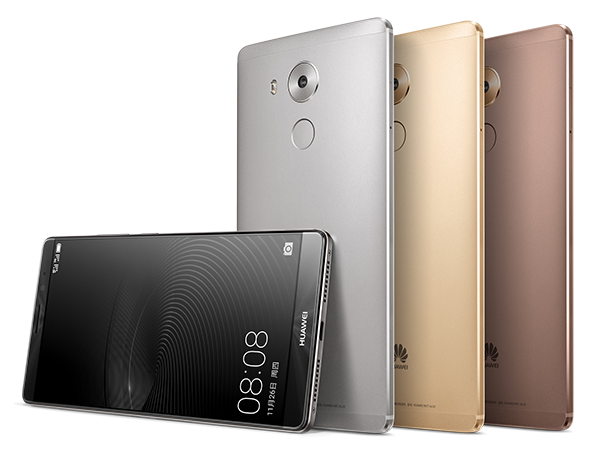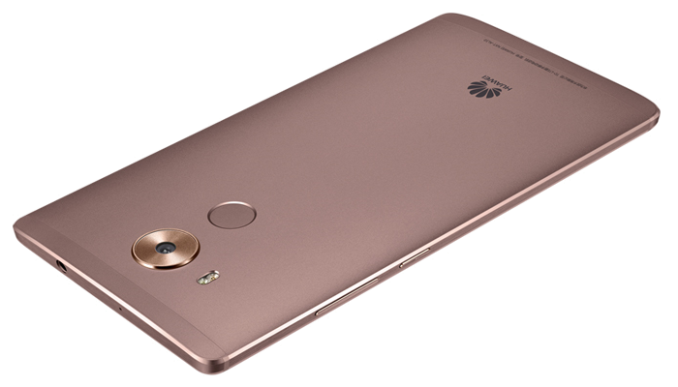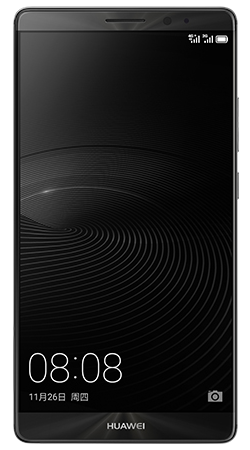Huawei Launches The Mate 8, with Kirin 950
by Andrei Frumusanu on November 26, 2015 1:30 AM EST- Posted in
- Smartphones
- Huawei
- Mobile
- Cortex A53
- Cortex A72
- Mali T880
- Kirin
- Mate 8

| Huawei Mate 8 | ||
| SoC | HiSilicon Kirin 950 4x Cortex A53 @ 1.8GHz 4x Cortex A72 @ 2.3GHz Mali-T880MP4 @ 900MHz |
|
| RAM | 3-4GB LPDDR4 | |
| NAND | 32GB / 64GB / 128GB NAND + microSD |
|
| Display | 6” 1080p JDI IPS-Neo LCD | |
| Modem | 2G/3G/4G LTE Cat 6 (Integrated HiSilicon Balong Modem) |
|
| Networks (NXT-AL10 Model) |
TDD LTE | B38 / B39 / B40 / B41 |
| FDD LTE | B1 / B2 / B3 / B4 / B5 / B7 / B8 / B12 / B17 / B18 / B19 / B20 / B26 | |
| UMTS | 850 / 900 / AWS / 1900 / 2100 ( B19 / B8 / B6 / B5 / B4 / B2 / B1) |
|
| GSM | 850 / 900 / 1800 / 1900 | |
| Dimensions | 157.1 (h) x 80.6 (w) x 7.9 (d) mm 185g weight |
|
| Camera | Rear Camera w/ OIS 16MP ( 4608 × 3456 ) Sony IMX298 1/2.8" w/ 1.12µm pixels F/2.0 aperture, ?mm eq. |
|
| Front Facing Camera 8MP ( 3264 × 2448 ) Sony IMX179 1/3.2" w/ 1.4µm pixels F/2.4 aperture, 26mm eq. |
||
| Battery | 4000mAh (15.2 Whr) | |
| OS | Android 6.0 with EmotionUI 4.0 |
|
| Connectivity | 802.11a/b/g/n/ac dual-band 2.4 & 5GHz BT 4.2, microUSB2.0, GPS/GNSS, DLNA, NFC |
|
| SIM Size | NanoSIM + NanoSIM (w/o microSD) |
|
| Chinese MSRP |
3GB + 32GB | ¥2999-3199 (USD~479, ~449€) |
| 4GB + 64GB | ¥3699 (USD~591, ~554€) | |
| 4GB + 128GB | ¥4399 (USD~703, ~659€) | |
At the heart of the Mate 8 lies HiSilicon's new Kirin 950 SoC. We attended the chipset's launch in Beijing just a couple of weeks ago and for the curious readers they can read a more in-depth look of the SoC in our announcement piece. To recap the new SoC is a big.LITTLE design with 4x Cortex A53 running up to 1.8GHz serving as high-efficiency cores and 4x Cortex A72 high performance cores running at 2.3GHz.
From the data that we've been presented with by Huawei and HiSilicon it looks like the new Kirin 950 has made very large strides in terms of power efficiency, so that'll be definitely a factor in the Mate 8's battery life. Indeed, with a similar 4000mAh battery and an efficienct SoC, Huawei promises that the Mate 8 will be able to last 30% longer than the Mate 7, a device which already topped our battery charts but due to the inefficiency of the SoC wasn't quite able to match up to its own predecessor at the time, the Mate 2.
On the GPU side we see a Mali T880MP4 running at up to 900MHz, while this is by no means a slouch, it'll fall only in the mid-range in terms of performance against 2016 devices as we'll see the competition using Qualcomm's Snapdragon 820 or Samsung's Exynos 8890's with configurations employing much more powerful graphics processing abilities. This is somewhat alleviated by Huawei's choice of keeping a 1080p resolution on the device's 6" IPS LCD screen.
To quickly refill that big battery, Huawei also announces fast charging of up to 2A at 9V or 18W, promising it can charge up to 37% charge in 30 minutes. Connectivity wise, the device is powered by the Category 6 integrated Balong LTE modem of the Kirin 950, although we'll have to wait on confirmtation of the exact frequency bands of the international model. Huawei has also finally upgraded their Wi-Fi implementation to include 802.11ac and also re-implements dual-band 2.4 and 5GHz support which was notoriously missing from this year's devices.
While on a recent trip to China we had the opportunity to have a hands-on with the Mate 8 and experience it live. As mentioned earlier, the device's defining characteristic is the large 6" display, and while the Mate 8 has kept this specification, it has slightly tweaked the ergonomics by giving it a larger curve on the back of the device resulting in edges that are thinner, making the device easier to hold. The front glass now also features 2.5D edges which give it a better feel than the plastic bezels around the Mate 7's screen. Huawei keeps publishing some rather deceptive looking device renders as it appears as if the screen has no bezels. This is unfortunately not representative of the device as it does have a ~1.5mm inactive border around the actual screen.
Other changes in design include the move to a bottom-placed speaker, now similar in design to the ones found on the P8 or the Mate S. The Mate 8 keeps the same camera, flash and fingerprint-sensor positioning of the Mate 7 but they all now use circular designs instead of square ones.
When speaking of the camera, we see the introduction of a new sensor module from Sony. The IMX298 is a new 1/2.8" 16MP unit with 1.12µm pixels and phase-detection auto-focus (PDAF) pixels. The optics on the camera module offer a F/2.0 aperture lens and also offers optical image stabilization (OIS) with up to 1.5° angle of movement. While trying out the camera I found that it seemed to offer quite good picture quality and the new ISP of the Kirin 950 seems to have certainly been part of some of the improvements in terms of the camera. Unfortunately due to the Kirin 950's encode limitations, the device doesn't offer 4K recording and is limited to more traditional 1080p video. On the front-facing camera we see a 8MP shooter, most likely the same sensor and module configuration found on the Mate S.
The device comes with two possible configurations and price-points: 3GB RAM with 32GB of NAND storage or 4GB RAM with 64GB or 128GB of storage. As seems to have become traditional for Huawei, the Mate 8 offers either dual-nanoSIM capability or you can use the second SIM slot as a microSD tray for additional storage. The phone ships with Android 6.0 Marshmallow with a new Huawei's EmotionUI 4.0 customization on top, and will initially be available in China from Q1 2016, while being introduced for western markets later on at CES. Chinese MSRPs for the 32GB, 64 and 128GB models come in at respectively RMB¥2999, ¥3699 and ¥4399.













21 Comments
View All Comments
StormyParis - Thursday, November 26, 2015 - link
No more FM radio ? I really liked it and used it surprisngly often on my (original) Ascend Mate.fackamato - Tuesday, December 8, 2015 - link
People stream radio these days (higher quality is a bonus).oliwek - Wednesday, December 9, 2015 - link
I doubt they stream radio outside of North America/Western Europe/some countries in Asia. You're stucked to FM in many countries if you are outside of big cities.StormyParis - Thursday, November 26, 2015 - link
$200 for an extra 1GB RAM and 96GB flash is a lot. Huapplei ?zeeBomb - Thursday, November 26, 2015 - link
I think the sensor focal equil. Is like 25mm...21x19 or somethingzeeBomb - Thursday, November 26, 2015 - link
Holy crap I'm excited... This device is going to be VERY exciting to see and hear reviews from. Still remember that footnote about the 920-935 having a "bad one" of the ISP (LOL), But that's vastly improved here, ain't it?Well, time to join the hype.
Lavkesh - Thursday, November 26, 2015 - link
If you havent read it still comes with the apalling so called emotion ui. I have the new G8 with the snapdragon 616 and 3 gb of ram and even then the phone is usless at doing basic tasks like web browsing, gaming is a total no go. Even something as generic as Subway Surfer is a laggy mess. I would not touch this even with a barge pole.gc2488 - Friday, November 27, 2015 - link
Looking forward to 4000mAh battery like this, and for competition and evolution in this area. I thought the 3700mAh battery of the Moto X Force was good, but this is even better. Huawei, now come out with a shatterproof screen and low price for unlocked US phone and you'll leap over Moto X Force which is being held back as Verizon-exclusive Droid Turbo 2 in US.HardwareDufus - Saturday, November 28, 2015 - link
Specs seem very compelling. (my Lumia 1520 has a 6" 1920x1080 screen... it is gorgeous....no need for Huawei to have gone 2560X1440... just extra processing that I don't is truly appreciated on a 6" screen).I like the color selection, silver, platinum, gold, bronze.
For Android folks, this looks like a great phone.
JoeMonco - Sunday, November 29, 2015 - link
"The device comes with two possible configurations and price-points: 3GB RAM with 32GB of NAND storage or 4GB RAM with 64GB or 128GB of storage."Pretty sure that's three possible configurations not two.